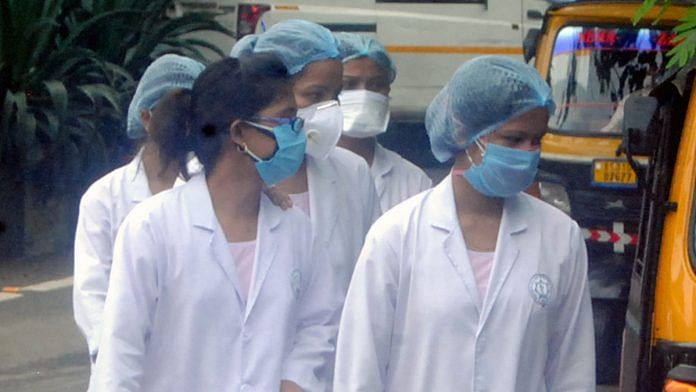The Union Budget for 2022-23 allocated Rs 86,200 crore to the health sector, which represents an increase of 16.6 per cent over previous year’s budget. Some experts in the health sector have criticised this increase as ‘inadequate’ especially when India was hit hard by the Covid-19 pandemic in the last two years. At the same time, others have pointed out the Narendra Modi government’s continued focus on creation of robust health infrastructure through its flagship schemes such as PM Ayushman Bharat Health Infrastructure Mission and the recently announced Ayushman Bharat Digital Mission.
However, amid the din and cacophony of budget allocations to the health sector, it is imperative that we continue our focus on one of the most important human capital in the sector – the ANM.
The ANM or auxiliary nurse midwife is the fulcrum of the rural health infrastructure in India. Being trained in basic healthcare such as administering vaccines and prescribing routine medicines such as IFA (Iron Folic Acid) tablets, she is the first point of contact for the rural patient with the government health system. She runs a sub-centre and is assisted by two or more ASHA (Accredited Social Health Activist) workers who are responsible for bringing the patient to the sub-centre. In a way, the ANM is a mini-doctor for the rural poor in a country where it is extremely difficult to get access to a doctor in the countryside. This is true for most states in India including Assam.
Also read: Modi govt schemes JSY, PMMVY work only if health workers do. See what data reveals
Where ANMs are lacking
Over the last many years, Assam has built a fairly robust public health infrastructure through the flagship National Health Mission (NHM). And this is being reflected in the improvement in the maternal and child health indicators as well as the state’s relatively better performance in Covid-19 management. However, taking a cross-section view, we still find Assam to be a state with one of the highest maternal and infant mortality rates.
UNICEF, in collaboration with the government of Assam, has carried out a pilot project in some districts of the state, Nagaon being one of them. The principal objective is to understand the critical gaps in our sub-centres and ANMs, which impede the state’s maternal and child health indicators and at the same time introduce certain cost-effective interventions that can play an important role in improving those indicators.
One of the factors contributing to high maternal mortality is high-risk pregnancy (HRP). From the field visits and surveys, it has emerged that ANMs may not be well equipped to detect HRPs at an early stage. It does not mean that the ANMs do not know what constitutes HRP. However, as multiple components such as anaemia, hypertension, diabetes, and infections are involved and in the absence of regular training or refresher courses, the ANMs sometimes forget to ask pregnant women all the relevant questions pertaining to HRP.
It was also seen that sometimes the ANMs are not immediately able to fill the details of the pregnant women in the Reproductive and Child Health (RCH) registers due to paucity of time or increased workload on a given Village, Health, Sanitation, and Nutrition (VHSN) day, which would have helped in detection of high-risk pregnancy. Early detection of HRP is key to lowering incidence of maternal and infant mortality.
Also read: If India can look after pregnant women so well, why are more under-5 kids wasting & stunting
Many ways to help ANMs
Based on the inputs from the field surveys, UNICEF has created a series of ready reckoners in simple Assamese for the benefit of the ANMs. These multicoloured cards help the ANMs in asking the right set of questions to the pregnant women to enable easier detection of HRPs, such as the history of previous abortions, time since last delivery, presence of any fever or infection as well as measurements of blood pressure, glucose and haemoglobin levels.
It is expected that this simple intervention will greatly help Assam’s primary healthcare workers in identifying HRPs in the early stage of pregnancy. It should also act as a tiny refresher course for the ANMs and brush up their memory on things they already know.
Similarly, the Nagaon district and health administration prepared a set of two small five-minute videos, which were circulated among the ANMs to enable them to ask the right questions on HRP to the pregnant women.
While UNICEF’s collaboration with the government of Assam is a positive step, we need more such simple interventions and regular training to adequately equip our human capital in the health sector. One such step can look into the possibility of utilising the services of senior and experienced ANMs as resource persons and trainers for refresher courses and best practices.
Another step is to identify the problems affecting delivery of healthcare at the primary level. There are a few studies that have looked into multiple factors affecting human capital at the grassroots level. These studies point to areas such as training, refresher courses, expanded scope of work, use of technology and supervision as areas of intervention. This enables policymakers in making the right intervention frameworks to address the challenges of capacity building.
At the same time, we need to encourage more discussion and debates around the working of our ANMs and ASHAs. We need more research and academic interest in this area. It is only through a larger dialogue that we can enable our policymakers to make the right policy prescriptions and interventions, which can strengthen and augment the functioning of our primary healthcare workers.
The author is Assistant Commissioner, Nagaon, Assam. He tweets @aranyaksaikia. Views are personal.
(Edited by Prashant)






